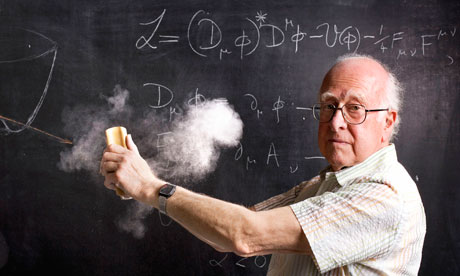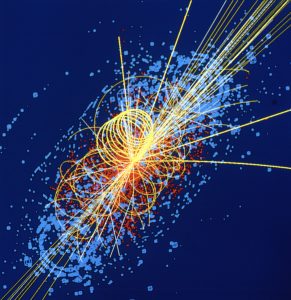Higgs Boson – God particle revealed?

What with the name “God”
 First of all, before explaining about this Higgs Boson particle, I must clear one thing first. God had nothing to do with this particle, or the one who so-named “God particle”, Leon Lederman didn’t intended to call it that way. Higgs Boson, commonly known as God particle, initially termed as “Goddamn particle” in his book called – The God Particle: If the Universe Is the Answer, What is the Question?, but because of the publisher of that book didn’t agree to use such harsh term, Lederman used the term “God particle”, in a way to explain that the search for this particle had very long history and it was so difficult to find the evidence of its existence. But you know media, they usually want more attention than truth, so the name “God particle” had stuck with Higgs Boson.
First of all, before explaining about this Higgs Boson particle, I must clear one thing first. God had nothing to do with this particle, or the one who so-named “God particle”, Leon Lederman didn’t intended to call it that way. Higgs Boson, commonly known as God particle, initially termed as “Goddamn particle” in his book called – The God Particle: If the Universe Is the Answer, What is the Question?, but because of the publisher of that book didn’t agree to use such harsh term, Lederman used the term “God particle”, in a way to explain that the search for this particle had very long history and it was so difficult to find the evidence of its existence. But you know media, they usually want more attention than truth, so the name “God particle” had stuck with Higgs Boson.
Where it started?
In order to understand what Higgs Boson is, we must know the basic ideas of physics and its roots and branches. I will try to keep everything as simple as possible. One of the important purpose of the science is to understand how we become what we are now, what is matter and why this universe works in such a way. In order to explore these things in details, science has branched out in two ways.
One of that ways is to understand how big things work, such as our sun, other stars, galaxies and this universe. More than 2000 years, men try to understand this, the principles of motion and heavenly bodies, as you know, our beloved Sir Isaac Newton in the 16th century first gave the idea by defining the gravity of motion, and in the 20th century, none other than Albert Einstein, took our understanding to the next level by proposing the “General Theory of Relativity”.
General theory of Relativity explains how big things works, it explains about gravity, space and time, but it is only good at enormously big things, it fails to gives us the details about how small things works, such as atoms, and even smaller sub atomic particles. For this reason another branch of science was created, just to understand how this tiny small things works.
Quantum mechanics, which explains the properties and behaviors of atomic and sub atomic particles, was established by some great minds of 20th century. Niels Bohr, Max Planck, Werner Heisenberg, even Einstein was awarded Nobel Prize for his contribution to quantum mechanics.
No single book can contain the full details about quantum mechanics or even its sub categories, so it is virtually impossible to explain them in a single article. I will help you establish some ideas about particles so you will understand what Higgs Boson is.
What’s with Quantum mechanics?
As we know, atom is highly stable “thing” so do molecules, if we apply the ideas of classical mechanics, atoms become highly unstable, and electrons would rapidly collide with nucleus of atom, make molecules impossible, thus nothing would have been created. So scientists realized that classical mechanics (includes Einstein’s General Relativity) in not complete model to explain everything in this universe, so new model has been created to explain the functions of atomic scale objects.
One problem for common reader is that ideas in the quantum mechanics are far more complex than common sense, sometimes it defies common sense. For example, here is a simple idea, electron, a sub atomic particle; it can exist in more than two places at the same time. It is not a copy of a single electron, but the electron itself can be at more than one place, so if something happens to one of itself, the effect is shown in all other selves instantly, even it is separated by millions of light years. It is wired right, but quantum mechanics has even more surprises.
Study of tiny particles
The advancement of quantum mechanics leads to far much sophisticated ideas about matter and energy. According to Relativity matter is nothing but dense amount of energy, thus linking matter and energy together. The famous one inch equation E=mc2 shows this relationship in plain sight.
Quantum mechanics explains about particle, which is matter, and about energy too. See the following points.
- Energy is not continuous, but comes in a certain quantity of unit, which was called “quanta” thus giving the name, quantum mechanics.
- The elementary particles such as electrons, behave like particles and also like weaves.
- It is impossible to know both the position and the velocity of the particle at the same time. More accurately one is measured, the less accurate other one is.
- Quantum world is insanely different than the world we live in, like the example I gave before.
This understanding of quantum world, led us to study more about particles, which created a new branch in physics, called particle physics. Particle physics studies about existence, behavior and dynamics of sub atomic particles, which creates matter and radiation.
The atom and with in
We know about the atoms, which are made of three subatomic particles, they are electrons, protons and neutrons. Protons and neutrons are combined to create the nucleus of an atom. But it’s not the whole story, because protons and neutrons are not elementary particles, which means, they are made of some other particle.
Quark is a fundamental elementary particle, a fundamental component of matter, quarks combine together to form protons and neutrons, which in terms combines to produced nuclei of an atom. But as far as we know, electron is an elementary particle with negative charge. Electrons have no known components.
The standard model
There are four fundamental forces in nature that are described by physics. Standard model in the particle physics mathematically explains about three fundamental forces of nature; electromagnetic force, weak nuclear force, and strong nuclear force. There is another force called gravity which is explained by General theory of Relativity. The problem is there is no single model or theory that can explain all those four forces in a single manner (more details on GUT theory – later). Standard model also does not include or explains anything about dark matter particles, which is estimated to contain 84% of matter in this universe.
The standard model has 61 elementary particles in three groups called, Bosons, Hadrons and Fermions. The classification and differences of these particles are out of scope of this article, but we are going to see about one particular particle called Higgs Boson, and this particle is somewhat special.
Higgs Boson – The Hunt
Higgs Boson, as explained above, one of the 61 particles in Standard model of particle physics. It is named after Peter Higgs, who proposed and explained about this particle and its mechanism in 1964 and in 1966 further developed the theory behind Higgs Boson and Higgs Mechanism.
One thing that baffled physicists was, when formulated the Standard Model, the mathematics behind that model, does not allow any particle to have mass, even though that mathematics explained other phenomena correctly, this mass issue was a big one, and it showed that the Standard Model was not as complete as expected.
In 1964, including Peter Higgs, few other physicists released papers on how particles can obtain mass, without breaking the mathematics behind the already existed Standard Model. The idea is now known as Higgs Mechanism – it is not same as Higgs Boson, Higgs Mechanism explains how particle can obtain mass, where Higgs Boson is an elementary particle that is responsible for this mechanism.
Higgs Mechanism was later experimentally confirmed, but physicists were not able to explain how the process happened. But simple theory is formulated to describe this mechanism, that theory suggested that some kind of field (such as magnetic field – just to imagine – Higgs field has nothing to do with magnetism) should exists and it interacts in a way with other fundamental particle, thus producing the so-called “mass”.
Since the 1960s Standard Model was developed with this “field” idea, therefore it suggested that one undiscovered particle must exist, and this particle must be from “boson” group, and it is Higgs Boson. If this particle is discovered, then physicist would be happy to know that the Standard Model is fundamentally correct and continue in the same direction; otherwise this Standard Model must be abandoned and alternative theories would be considered.
So since then the hunt for Higgs Boson was started, but the problem with detecting Higgs Boson is that Higgs Boson decays into other particles so quickly thus detecting it directly is impossible, and it also require high energy to create trace after the particle collision to detect its existence.
The Discovery
In 2008 Large Hadron Collider (LHC) was built by CERN, and it is the most powerful particle accelerator ever built, even some might argue that the sole purpose of the LHC is to find the evidence of Higgs Boson.
In the particle accelerators, sub atomic particles are accelerated to high speed such as near light speed with the help of super magnets, and allowed to collide, and when they collide, high accurate detectors will detects the remnants and traces of decay of the collision.
In July 2012, CERN announced that it detected a new particle, a boson, and suggested this might be Higgs Boson. CERN said the behavior of Higgs Boson suggested by Standard Model somewhat matching with the experimental discovery. But physicists have not confirmed this new particle as Higgs Boson, in order to confirm, more data and analysis is required.
But if this new boson particle is other than Higgs, then new theory must be developed to support the new particle with current Standard Model.
The media frenzy behind this so-called discovery is because of the local name given to this Higgs Boson, the God Particle, like I said before, the term “God” in this God Particle, was never intended in a way that the word “God” is intended in religions.
But nonetheless, if this particle is confirmed to exist, then this will be a truly another mile stone in science and we might be one step closer to know the secret of our universal existence.


